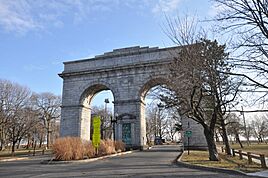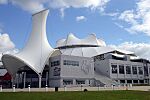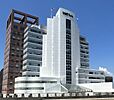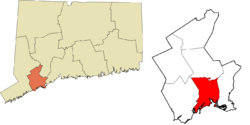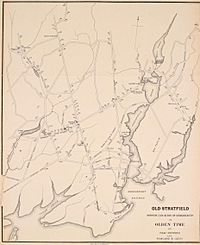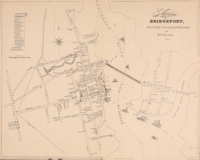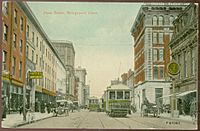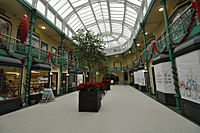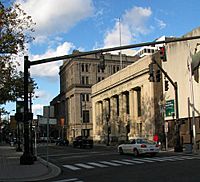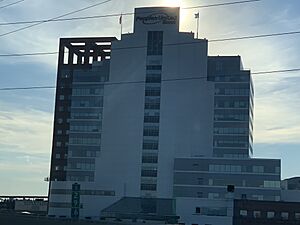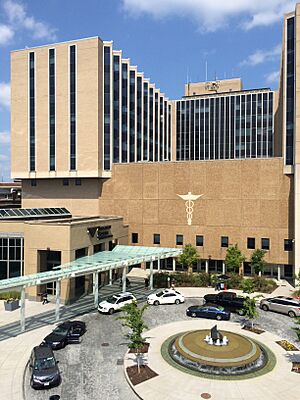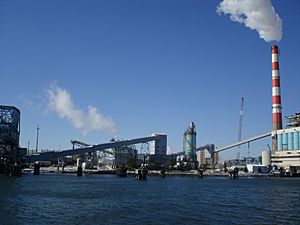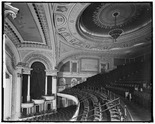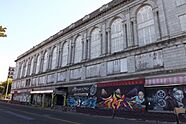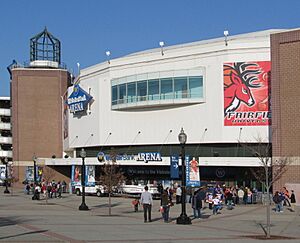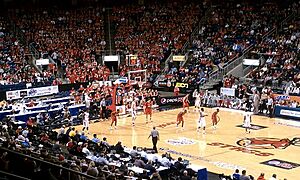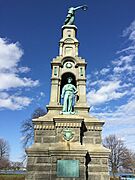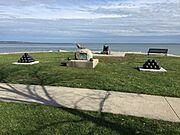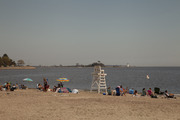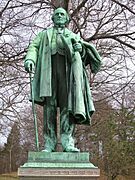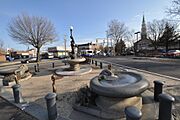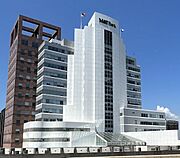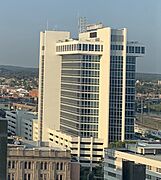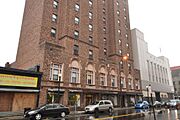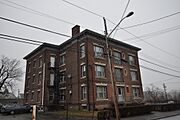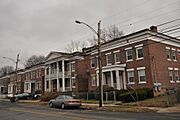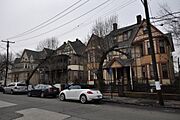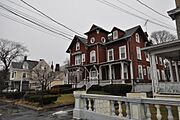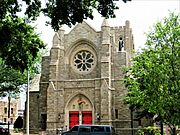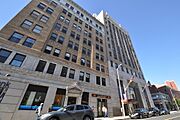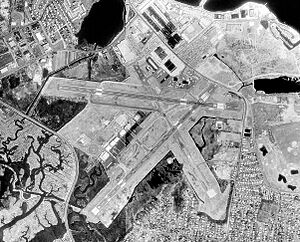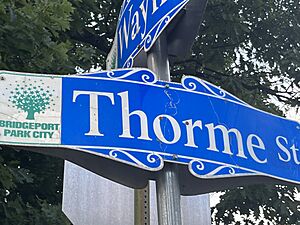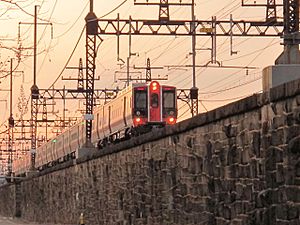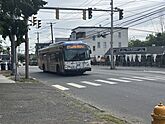Bridgeport, Connecticut facts for kids
Quick facts for kids
Bridgeport
|
|||||
|---|---|---|---|---|---|
|
Perry Memorial Arch, facing southwards towards Seaside Park
Downtown Bridgeport
Total Mortgage Arena
Bridgeport Station
Bridgeport Center
Connecticut's Beardsley Zoo
|
|||||
|
|||||
| Nicknames:
The Park City, BPT
|
|||||
Motto(s):
|
|||||
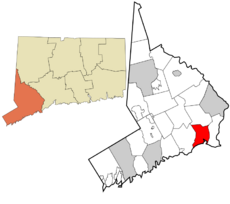 Fairfield County and Connecticut Fairfield County and Connecticut |
|||||
| Country | United States | ||||
| State | Connecticut | ||||
| County | Fairfield | ||||
| Region | CT Metropolitan | ||||
| MSA | Bridgeport-Stamford-Norwalk | ||||
| CSA | New York | ||||
| Incorporated (town) | 1821 | ||||
| Incorporated (city) | 1836 | ||||
| Named for | A drawbridge over the Pequonnock River | ||||
| Government | |||||
| • Type | Mayor-council | ||||
| Area | |||||
| • City | 19.4 sq mi (50.2 km2) | ||||
| • Land | 16.0 sq mi (41.4 km2) | ||||
| • Water | 3.4 sq mi (8.8 km2) | ||||
| • Urban | 397.29 sq mi (1,029.0 km2) | ||||
| Elevation | 3 ft (1 m) | ||||
| Population
(2020)
|
|||||
| • City | 148,654 | ||||
| • Rank | US: 172nd | ||||
| • Density | 9,290.875/sq mi (3,587.228/km2) | ||||
| • Urban | 916,408 (US: 51st) | ||||
| • Urban density | 2,306.6/sq mi (890.6/km2) | ||||
| • Metro | 939,904 (US: 57th) | ||||
| Demonym(s) | Bridgeporter | ||||
| GDP | |||||
| • Bridgeport (MSA) | 4.368 billion (2022) | ||||
| Time zone | UTC−5 (Eastern) | ||||
| • Summer (DST) | UTC−4 (Eastern) | ||||
| ZIP Codes |
06601–06602, 06604–06608, 06610, 06650, 06673, 06699
|
||||
| Area code(s) | 203/475 | ||||
| FIPS code | 09-08000 | ||||
| GNIS feature ID | 205720 | ||||
| Airport | Sikorsky Memorial Airport | ||||
| Major highways | |||||
| Commuter rail | |||||
Bridgeport is the largest city in Connecticut by population. It is also the fifth-largest city in New England. In 2020, about 148,654 people lived there. Bridgeport is located in Fairfield County where the Pequonnock River meets Long Island Sound. It is a port city, about 60 miles (97 km) from Manhattan.
Bridgeport was first settled by the Paugussett Native American tribe. English settlers arrived in the 1600s. The area became a town in 1821 and a city in 1836. P. T. Barnum, a famous showman, lived in Bridgeport and was even its mayor in 1871. He kept his circus in the city during the winter. In the early 1900s, Bridgeport grew a lot and became a major manufacturing city.
Bridgeport was home to some cool firsts:
- The world's first mutual telephone exchange (1877).
- The first dental hygiene school (1949).
- The first bank telephone bill service in the U.S. (1981).
- Inventor Harvey Hubbell II invented the electric plug outlet here in 1912.
- The Frisbie Pie Company started in Bridgeport.
- The world's first Subway restaurant opened in the city in 1965.
After World War II, many large companies left Bridgeport. This caused the city to face challenges with jobs and residents moving away. However, since the early 2000s, Bridgeport has been working hard to rebuild its downtown and other areas. The crime rate has also gone down a lot since 2010.
Bridgeport has three museums, the University of Bridgeport, and Connecticut's only zoo. The city is known as "Park City" because it has 35 public parks covering 1,300 acres. Bridgeport is also known for being one of the most diverse cities in the United States.
Contents
History of Bridgeport
Early Settlements and Growth
The first English settlement in Bridgeport happened in 1644. It was near Black Rock Harbor. The area was called Pequonnock by the Paugussett Native Americans. This name means "Cleared Land." Golden Hill was a special place for them, with natural springs and planting fields. The Connecticut Colony gave the Golden Hill Indians a reservation here in 1639.
In its early days, Bridgeport relied on fishing and farming. A small village called Newfield started around State and Water Streets in the 1760s. The area officially became known as Stratfield around 1695. This name came from its location between the towns of Stratford and Fairfield. During the American Revolution, Newfield Harbor was a hub for privateering, where private ships attacked enemy vessels.
Bridgeport in the 1800s
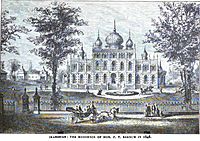
By 1781, many local farmers were involved in trade from Newfield Harbor. The village traded with cities like Boston, New York, and Baltimore. It also traded internationally with the West Indies. In 1800, the village became the Borough of Bridgeport. It was named after the Newfield or Lottery Bridge over the Pequonnock River. Bridgeport Bank was started in 1806. In 1821, Bridgeport became its own town, separate from Stratford.
The whaling industry and steamship companies grew in the 1820s and 1830s. The Housatonic Railroad started in 1836. The same year, the New York and New Haven Railroad began. This connected Bridgeport to New York City and other towns along Long Island Sound.
Bridgeport quickly became an industrial city. After the American Civil War, it had many iron foundries and factories. These factories made firearms, metallic cartridges, horse harnesses, locks, and blinds. Wheeler & Wilson's sewing machines were sold worldwide. In 1870, Bridgeport added the West End and the village of Black Rock. In 1875, P. T. Barnum was elected mayor. Bridgeport then became the winter home for his famous Barnum and Bailey's Circus.
Bridgeport in the 1900s
From 1870 to 1910, Bridgeport became a major industrial center in Connecticut. Its population grew from about 25,000 to over 100,000 people. Many immigrants from Ireland, Slovakia, Hungary, Germany, England, and Italy moved there. A Singer factory also made sewing machines. The Locomobile Company of America made early automobiles. Bridgeport was also a center for making corsets. It became the main office for Remington Arms in 1912.
During World War I, Bridgeport continued to grow. Before the Great Depression, the city had over 500 factories. This included Columbia Records' main record pressing plant. The preparations for World War II helped the city recover in the late 1930s.
After the mid-1900s, many factories closed. This caused thousands of jobs and residents to leave Bridgeport. Like other cities, Bridgeport faced challenges in the 1970s and 1980s. New homes in the suburbs attracted wealthier residents. This left the city with more people facing poverty. The city also had problems with how it was managed. In 1991, the city tried to file for bankruptcy, but a court said it was financially stable.
Bridgeport in the 2000s
In the early 2000s, Bridgeport began to rebuild its downtown and other neighborhoods. In 2004, old department stores were turned into artists' lofts. Other buildings were converted into apartments. The Great Recession slowed down some big projects, like a $1-billion waterfront development. However, other projects continued, like the Bijou Square apartments. In 2009, the city approved a new plan for development. This plan aimed to encourage new projects and protect existing neighborhoods.
Famous Speeches in Bridgeport
On March 10, 1860, Abraham Lincoln gave a speech in Washington Hall. This was an auditorium at the old Bridgeport City Hall. The room was full, and a crowd gathered outside. Lincoln received a standing ovation. A plaque now marks the spot where he spoke. Later that year, he was elected president.
The Rev. Martin Luther King Jr. spoke three times at the Klein Auditorium in the 1960s. President George W. Bush also spoke in Bridgeport in 2006. President Barack Obama visited the Harbor Yard arena in 2010 to support Governor Dan Malloy.
Geography and Nature
Location and Features
Bridgeport is located along Long Island Sound. It sits at the mouth of the Pequonnock River. This river was named after the Native American tribe who lived along its banks.
Parks and Green Spaces
Bridgeport is famous for its public parks. This is why it's called "The Park City." The city's first public park was McLevy Green, set aside in 1806. Other early public spaces included Clinton Park Militia Grounds (1666) and Old Mill Green (1717).
As the city grew, people saw the need for more parks. By 1864, P. T. Barnum and others helped create Seaside Park. This park has grown to 375 acres (1.5 km²). In 1878, over 100 acres (0.4 km²) of land along the Pequonnock River became Beardsley Park. Both Seaside and Beardsley Parks were designed by Frederick Law Olmsted. He is famous for creating Central Park in New York City. Other parks include Beechwood Park and Pleasure Beach, which used to have a popular amusement park.
Neighborhoods of Bridgeport
Bridgeport is divided into many different neighborhoods. These are grouped into five main areas: Downtown, the East Side, the North End, the South End, and the West Side.
- Downtown
- McLeevy Green
- Harral Square
- The Hollow
- Enterprise Zone
- East Side
- Boston Avenue/Mill Hill
- East End
- Lower East Side
- Newfield
- Pleasure Beach
- Steel Point
- Upper East Side
- North End
- Brooklawn/St. Vincent
- Lake Forest
- Lake Success
- North Bridgeport/Little Italy
- Reservoir/Whiskey Hill
- South End
- Seaside Park
- Soundgate
- West Side
- Black Rock
- West End
Bridgeport's Climate
Bridgeport has a climate that is a mix of humid subtropical and humid continental. This means it has warm, humid summers and cold winters. The average temperature in January is about 30.1°F (-1.1°C). In July, it's about 74.3°F (23.5°C). Temperatures rarely reach 0°F (-18°C) or 100°F (38°C).
The city gets about 42.7 inches (1,080 mm) of rain each year. Rain is spread out throughout the year. Snowfall averages about 27.6 inches (70 cm) per winter. Snow usually falls from December to March. Snow doesn't stay on the ground for very long in coastal Connecticut.
People and Diversity
| Historical population | |||
|---|---|---|---|
| Census | Pop. | %± | |
| 1810 | 1,089 | — | |
| 1820 | 1,500 | 37.7% | |
| 1830 | 2,800 | 86.7% | |
| 1840 | 3,294 | 17.6% | |
| 1850 | 7,560 | 129.5% | |
| 1860 | 13,299 | 75.9% | |
| 1870 | 18,969 | 42.6% | |
| 1880 | 27,643 | 45.7% | |
| 1890 | 48,866 | 76.8% | |
| 1900 | 70,996 | 45.3% | |
| 1910 | 102,054 | 43.7% | |
| 1920 | 143,555 | 40.7% | |
| 1930 | 146,716 | 2.2% | |
| 1940 | 147,121 | 0.3% | |
| 1950 | 158,709 | 7.9% | |
| 1960 | 156,748 | −1.2% | |
| 1970 | 156,542 | −0.1% | |
| 1980 | 142,546 | −8.9% | |
| 1990 | 141,686 | −0.6% | |
| 2000 | 139,529 | −1.5% | |
| 2010 | 144,229 | 3.4% | |
| 2020 | 148,654 | 3.1% | |
| Population 1840–1970 U.S. Decennial Census 2018 Estimate |
|||
Population Overview
In 2020, Bridgeport had 148,654 people. The city is very diverse. About 39.6% of residents were White, 34.6% Black or African American, and 3.4% Asian in 2010. About 38.2% of the population was Hispanic or Latino.
Many households in Bridgeport have children under 18. The average household size is 2.70 people. The median age in the city is 31 years old.
Languages and Cultures
In Bridgeport, many different languages are spoken at home. In 2020, about 48.2% of people spoke a language other than English. Spanish is spoken by 33.8% of the population. Bridgeport has the largest percentage of Hispanic Americans in Connecticut. It also has one of the largest communities of Puerto Ricans in the United States.
Bridgeport also has a large Mexican population. Dominicans are also a significant group. Many people from Central America and South America live in Bridgeport. This includes people from Ecuador, Colombia, and Peru.
The city also has a large Portuguese-speaking community. This includes people from Cape Verde and Portugal. Many Brazilians also live in Bridgeport, especially in the North End.
Bridgeport is home to people from many different Muslim nations. The city's public schools now observe Eid al-Fitr. Bengali is the fifth most common language in Bridgeport Public Schools. There is also a notable Kurdish community. Asian residents include people from Vietnam, India, China, and the Philippines.
Jamaicans are also a large group in Bridgeport. In total, at least 92 languages are spoken by students in Bridgeport Public Schools.
Bridgeport is known for its diversity. It is often ranked as one of the most diverse cities in the U.S.
Economy and Jobs
Bridgeport's economy has changed over time. It used to be a big industrial city. Companies like General Electric and Remington Products had factories here. The last major factory, a Sikorsky helicopter plant, closed in 2015. Many famous companies that started in Bridgeport, like ACME Sheer and Hubbell Incorporated, are now in nearby towns. Subway, which began in Bridgeport, is now based in Milford.
Today, Bridgeport's economy focuses on services. Healthcare, finance, and education are very important. The two biggest employers are the city's main hospitals: Bridgeport Hospital and St. Vincent's Medical Center.
In 2022, M&T Bank merged with a Bridgeport-based bank. Bridgeport Center became the regional headquarters for M&T Bank in New England.
Top Employers in Bridgeport
Here are some of the top employers in Bridgeport:
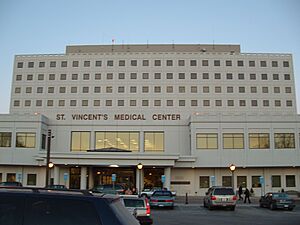
| # | Employer | # of employees |
|---|---|---|
| 1 | Bridgeport Hospital | 3,243 |
| 2 | St. Vincent's Medical Center | 1,800 |
| 3 | M&T Bank | 1,117 |
| 4 | Jewish Senior Services Center | 358 |
| 5 | Goodwin University | 526 |
| 6 | Sikorsky Aircraft | 383 |
| 7 | Housatonic Community College | 343 |
| 8 | Lacey Manufacturing Co. | 350 |
| 9 | Bridgeport Healthcare Center | 297 |
| 10 | alphabroder Prime Line | 253 |
Arts and Fun Things to Do
Live Shows and Music
Bridgeport has several places where you can see live theater and music:
- Downtown Cabaret Theatre: Offers cabaret, children's theater, and concerts.
- The Stress Factory: A comedy club with national and local comedians.
- Klein Memorial Auditorium: Home to the Greater Bridgeport Symphony and touring shows.
- Total Mortgage Arena: Hosts sports events and large concerts.
- Hartford HealthCare Amphitheater: An outdoor concert venue.
Bridgeport also hosts the Sound on Sound Music Festival at Seaside Park. Famous artists like John Mayer and Red Hot Chili Peppers have performed there. The Greater Bridgeport Symphony has been performing since 1945.
Museums and Zoos
- The Discovery Science Center and Planetarium: Focuses on science exhibits. It has Connecticut's only Challenger Center, which is part of the national space program.
- The Housatonic Museum of Art: Located at Housatonic Community College. It has the largest art collection of any two-year college in the country.
- The Barnum Museum: Celebrates the showman P. T. Barnum and Bridgeport's history.
- The Beardsley Zoo: Opened in 1922, it is Connecticut's only zoo and the largest in the state.
The Maritime Aquarium at Norwalk is also nearby, about 30 minutes from downtown Bridgeport. It focuses on Long Island Sound and marine life.
Historic Places and Food
Bridgeport has five local historic districts. These areas have special rules to protect their old buildings.
- Black Rock Harbor Historic District
- Pembroke City Historic District
- Stratfield Historic District
- Barnum-Palliser Development Historic District
- Marina Park Historic District
- Downtown North Historic District
- Downtown South Historic District
- Remington City Historic District
- Black Rock Gardens Historic District
- Seaside Village Historic District
- AMFAB Art Building
Bridgeport is known for its diverse food scene. It has been ranked as a "foodie city." You can find many different types of restaurants, especially Brazilian and Portuguese ones in neighborhoods like the Hollow. There are also highly-rated Mexican and Vietnamese restaurants.
Sports in Bridgeport
| Club | League | Venue | Established | Championships |
|---|---|---|---|---|
| Bridgeport Islanders | AHL | Total Mortgage Arena | 2001 | 0 |
| CT United FC | MLS Next Pro | New Waterfront Stadium | 2024 | 0 |
The Total Mortgage Arena is a big sports and event center. It seats 10,000 people. It is the home ice for the Bridgeport Islanders, an American Hockey League hockey team. They are the minor league team for the New York Islanders. Starting in 2024, the arena will also be home to the New York Sirens of the Professional Women's Hockey League.
The arena has also hosted college basketball games for Fairfield University.
The Ballpark at Harbor Yard used to be a minor-league baseball stadium. It was home to the Bridgeport Bluefish from 1998 to 2017. The ballpark has since been turned into an outdoor concert venue.
Kennedy Stadium is a community sports facility. It has hosted football teams in the past.
The Nutmeg Curling Club, one of two curling clubs in Connecticut, is in Bridgeport.
Bridgeport native Jim O'Rourke was the first baseball player to get a hit in National League history in 1876.
In early 2024, Bridgeport was chosen for a new professional soccer team, Connecticut United FC. They plan to play at a new stadium on the waterfront.
Parks and Recreation
- Photos from Bridgeport's public parks
Bridgeport has 1,300 acres (5.3 km²) of public space. There is a small park in almost every neighborhood. This is why Bridgeport is called "the Park City." The city's first public park was McLevy Green, created in 1806.
Seaside Park was created in 1864 with help from P. T. Barnum. It is now 375 acres (1.5 km²). In 1878, Beardsley Park was added. Both parks were designed by Frederick Law Olmsted, who also designed New York City's Central Park. Other parks include Beechwood Park and Pleasure Beach, which used to have an amusement park.
Architecture and Buildings
- Notable buildings and architectural styles in Bridgeport
-
Bridgeport Center – An 18-floor postmodern building designed by Richard Meier and built 1989. It is the tallest building in Bridgeport.
-
Park City Plaza – an 18-story modernist style building completed in 1973.
-
Queen Anne style tenements in the Barnum Palliser historic district.
-
1870s Victorian homes on the East Side.
-
Golden Hill United Methodist Church near City Hall.
Bridgeport did not get as many tall, modern skyscrapers as other cities in the 1970s and 80s. This was because many large companies moved to other parts of Fairfield County. The tallest building in Bridgeport is the Bridgeport Center. It is 16 stories tall and was built in 1989. It was designed by Richard Meier.
In the early 1900s, Bridgeport stopped building "triple decker" homes. These were common in areas like the Hollow and the East Side. You can still find many Victorian homes and other older styles in the city's neighborhoods.
Education and Learning
Colleges and Universities
Bridgeport is home to several colleges:
- University of Bridgeport
- Housatonic Community College
- Paier College
- St. Vincent's College
- The Yeshiva Gedola of Bridgeport
Sacred Heart University is located nearby in Fairfield, with part of its campus in Bridgeport. It is the second-largest Catholic university in New England. Paier College is the only private arts college in Connecticut.
Public Schools
The Bridgeport Public Schools system is the second largest in Connecticut. It has about 20,800 students. The system includes 30 elementary schools, three main high schools, and special programs. The city is also working on renovating and building new schools.
Public High Schools
- Bassick High School: Serves students from the southern parts of the city.
- Central High School: Established in 1876, it includes a magnet program. It serves students from the northern parts of the city.
- Warren Harding High School: Offers an International Baccalaureate Program. It serves students from the East End and East Side.
- Bridgeport Regional Vocational Aquaculture School (BRVAS): A special school focusing on marine life and aquaculture. It is open to students from Bridgeport and nearby towns.
Public Magnet High Schools
- Fairchild Wheeler Interdistrict Multi-Magnet High School: This school has three specialized STEM high schools in one building. These focus on IT, aerospace, and biotechnology. Students are chosen by a lottery.
- Central Magnet: Part of Central High School, this is a public preparatory magnet school.
Public Military and Trade High Schools
- Bridgeport Military Academy (BMA): For students interested in public safety careers.
- Bullard-Havens Technical High School: A vocational high school that teaches trades.
Other Schools
Bridgeport also has several charter schools and private schools. These include The Bridge Academy, Achievement First Bridgeport Charter High School, and Kolbe Cathedral High School.
Media and Entertainment
Radio Stations
- WCUM AM 1450: A Spanish-language station.
- WICC-AM 600: One of the oldest radio stations in Connecticut, broadcasting since 1926.
- WEBE-FM 107.9: Plays "Connecticut's Best Music Variety."
- WEZN-FM 99.9: Plays "Today's Best Mix."
- WPKN-FM 89.5
Newspapers
- Elsolnews.com: A Spanish-language weekly newspaper.
- HaitianVoice.com: Covers local news in English, Haitian Creole, and French.
- Brazil News: Covers stories from Bridgeport in Portuguese.
- Connecticut Post: The main daily newspaper for Bridgeport and the surrounding area.
Television
While Bridgeport mainly gets TV channels from New York City or New Haven, some local stations operate:
- WEDW channel 49: A Connecticut Public Television station.
- WTNH-TV has a satellite studio in downtown Bridgeport.
- WZME channel 43: A Story Television affiliate.
- News 12 Connecticut: A cable news channel for local news.
Movies and TV Shows Filmed in Bridgeport
Many movies and TV shows have been filmed or partially filmed in Bridgeport.
- Officer Down (2012)
- A Dance for Grace (2010)
- Ironmen (2010)
- 3 Weeks to Daytona (2009)
- Accidental Mayor (2009)
- All Good Things (2009)
- Confessions of a Shopaholic (2009)
- Dear Beautiful (2009)
- The Godfather Musical Part III: Luca Brasi Sleeps with the Fishes (2009)
- House of Satisfaction (2009)
- Made for Each Other (2009)
- The Music of Erich Zann (2009/II)
- Old Dogs (2009/I)
- College Road Trip (2008)
- Indiana Jones and the Kingdom of the Crystal Skull (2008)
- Pistol Whipped (2008)
- Righteous Kill (2008)
- The Sisterhood of the Traveling Pants 2 (2008)
- What Just Happened (2008)
- Bobby Dogs (2007)
- Dear Beautiful (2007)
- Praying to Hendrix (2007)
- Die Hard with a Vengeance (1995)
- A Walk with Death (1993)
- Route One USA (1989)
- There's a Nightmare in My Closet (1987)
- Without a Trace (1983)
- The Case of the Cosmic Comic (1976)
- The Effect of Gamma Rays on Man-in-the-Moon Marigolds (1972)
- The Light that Failed (1916)
- Kitchen Nightmares (Season 4, Episode 7, "Tavolini Restaurant", 2011)
- Brian Boitano Skating Spectacular (2010) (TV)
- Ghost Adventures:"Remington Arms Factory" (Episode 21, November 2009)
- WWE Raw (Many episodes from 2002-2012)
- WWE Smackdown, ECW, and NXT (Many episodes from 2002-2011)
- Oprah Winfrey Presents: Mitch Albom's For One More Day (2007)
- WWE Raw's 15th Anniversary Special (2007)
- Flip This House: "Burning Down the House" (2005)
- Extreme Makeover: Home Edition (2003 & 2007)
- Made in America (2003)
- U.S. Bounty Hunter (2003)
- Muggsy (1976)
- The Twentieth Century (1957, The Class of '58 episode)
- Johnny, We Hardly Knew Ye (TV movie, 1977)
- Live PD (2016–2017)
- Family Guy 2010
- Sneaky Pete (2015–)
City Services and Travel
Getting Around Bridgeport
Airports
Sikorsky Memorial Airport is in nearby Stratford. It used to offer commercial flights but stopped in 1999. Other airports are a bit further away.
| General aviation airports | Distance from Downtown/location |
|---|---|
| Sikorsky Memorial Airport | 3 miles east in Stratford, Connecticut |
| Danbury Municipal Airport | 20 miles northwest in Danbury, Connecticut |
| Waterbury–Oxford Airport | 21 miles north in Oxford, Connecticut |
| Teterboro Airport | 50 miles southwest in Teterboro, New Jersey |
| Regional airports | Distance form Downtown/location |
|---|---|
| Tweed New Haven Airport | 17 miles east in East Haven, Connecticut |
| Westchester County Airport | 28 miles west in Westchester County, New York |
| International airports | Distance from Downtown/location |
|---|---|
| LaGuardia Airport | 45 miles southwest in Queens, New York |
| John F. Kennedy International Airport | 48 miles southwest in Queens, NY |
| Stewart International Airport | 52 miles northwest in Newburgh, New York |
| Bradley International Airport | 58 miles northeast in Windsor Locks, Connecticut |
| Newark Liberty International Airport | 61 miles southwest in Newark, New Jersey |
Roads
Major highways in Bridgeport include Interstate 95. This highway runs east-west near the coast. Route 8 and Route 25 run north-south. These routes connect to the Merritt Parkway in nearby Trumbull. U.S. 1 (the Boston Post Road) also runs through the city.
Trains and Ferries
Bridgeport has train service to New York City through Amtrak and Metro-North. Many people who live in Bridgeport commute to jobs in New York. You can also take trains to Waterbury and New Haven.
The Bridgeport & Port Jefferson Ferry takes cars and passengers across Long Island Sound to Port Jefferson, New York.
Buses
The Greater Bridgeport Transit Authority (GBTA) provides bus service within Bridgeport and its nearby towns. You can also take intercity buses like Greyhound to other cities.
Emergency Services
Fire Department
The Bridgeport Fire Department provides fire protection and emergency medical services to the city.
Emergency Medical Services
American Medical Response provides emergency medical services in Bridgeport.
Notable People from Bridgeport
- Brian Dennehy (1938–2020), actor
- Joe Ganim (born 1959), mayor of Bridgeport
- Sadie Griffin (1877–1958), politician
- Albert L. Lehninger (1917–1986), biochemist
- John Mayer (born 1977), guitarist and singer/songwriter
- Anita McBride, former chief of staff to the First Lady of the United States
- Robert Mitchum (1917–1997), actor
- Alyssa Naeher (born 1988), goalkeeper for the U.S. women's national soccer team
- Justin Quiles (born 1990), singer/songwriter
- Victoria Leigh Soto (1985–2012), a brave teacher during the Sandy Hook Elementary School shooting
- Vinnie Vincent (born 1952), guitarist and songwriter
- Larry Kramer (1935–2020), playwright and activist
See also
 In Spanish: Bridgeport para niños
In Spanish: Bridgeport para niños


